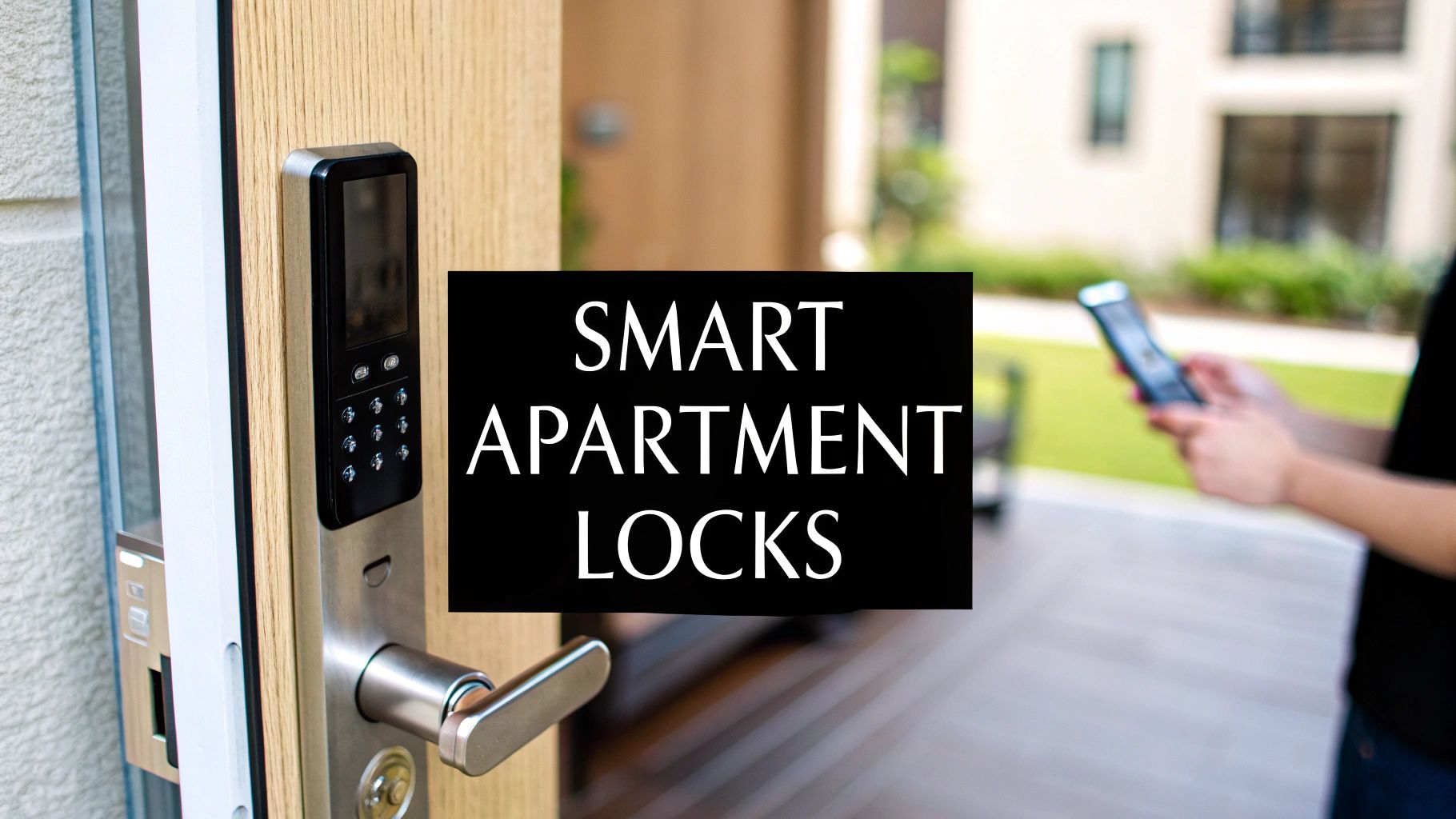For any property manager, that overflowing drawer of old metal keys is a constant source of headaches. It's a symbol of wasted time, nagging security risks, and operational chaos. Smart locks for apartments are the answer, finally replacing the expensive cycle of rekeying and late-night lockout calls with secure, digital access. This isn't just a minor upgrade; it's a fundamental shift in how apartment access is managed.
Moving Beyond Metal Keys in Apartment Living
We've all been there—staring at a massive, clunky keyboard with dozens of labeled keys. Each one represents a potential problem. When a tenant moves out, it's a security hole until you rekey. When a key is lost, it's an immediate expense. The whole process, from coordinating handoffs to dealing with emergency lockouts, is just clunky and inefficient.
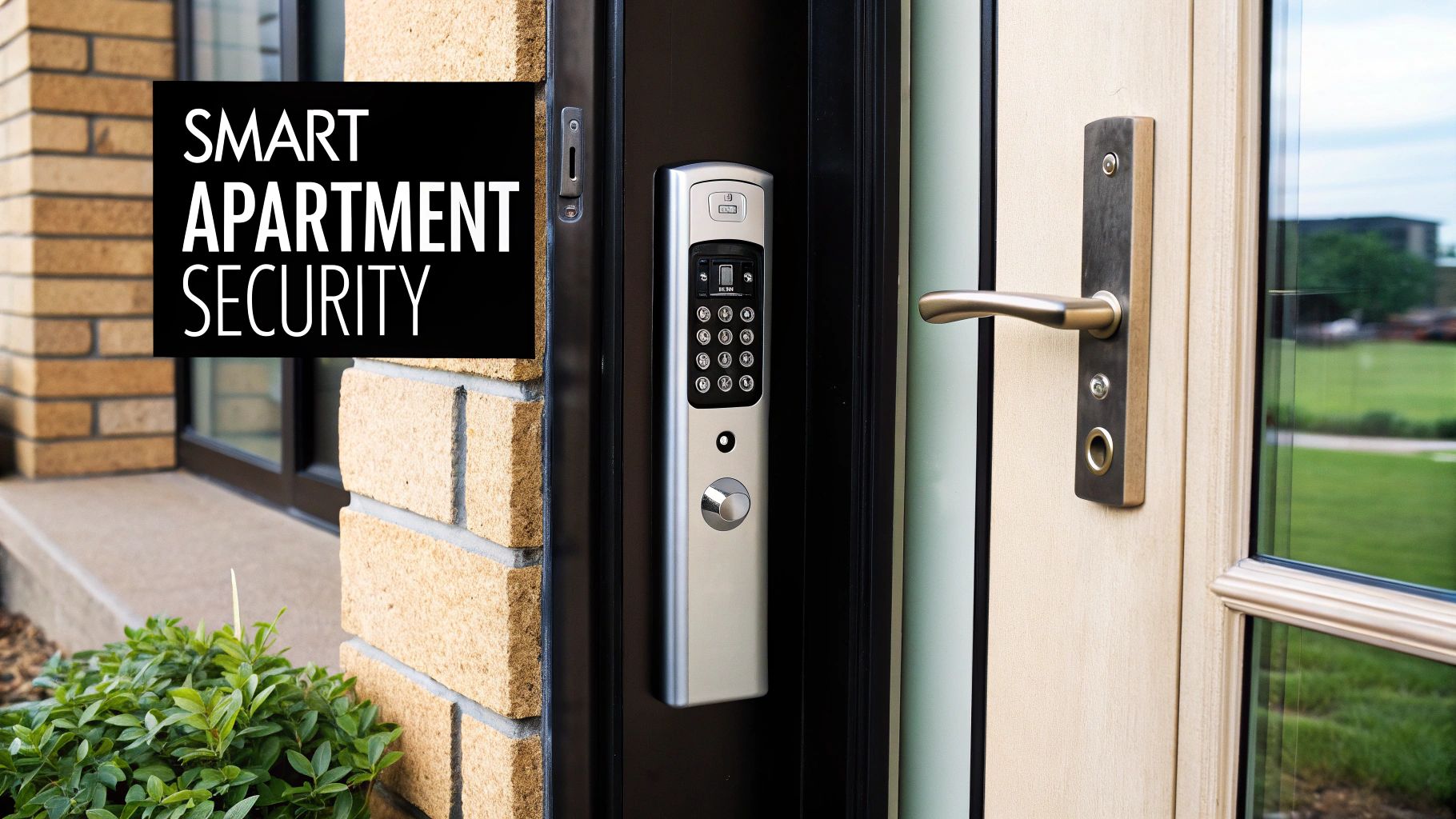
This guide isn't just about defining what a smart lock is. It's about tackling these real-world frustrations head-on and showing how this technology can solve the persistent problems that physical keys create for apartment operators.
The Modern Renter Expects More
Today's renters are looking for more than just four walls and a roof; they want a connected, convenient living experience. It's no surprise that a recent report found 54% of renters now consider smart locks a standard feature in a modern apartment. What's truly telling is that 58% are willing to give up traditional amenities like a pool or gym just to have smart home tech.
This change in priorities is a massive opportunity for property owners. Smart locks have moved from being a "nice-to-have" perk to a real factor in a renter's decision-making process. They directly meet the modern resident’s need for:
- Convenience: No more fumbling for keys. Unlocking the door with a phone or a simple PIN code is a game-changer.
- Security: Residents gain peace of mind knowing that old tenants' access can be revoked instantly and that there’s a digital log of who entered and when.
- Control: Granting temporary access to a dog walker, a cleaner, or a visiting family member from an app gives residents a sense of freedom and control over their space.
It turns out smart home security tech is now the single biggest factor influencing how safe renters feel. A recent survey showed 36% of renters value it even more than having on-site security staff or knowing their neighbors.
Laying the Foundation for a Smarter Property
Switching to smart locks is about more than just swapping out a piece of hardware on the door. It's the first and most important step in creating a smarter, more efficient building. Think of it as the groundwork for a larger system. This evolution from metal keys to digital credentials is part of the broader world of modern electronic access control systems.
By adopting this technology, you're not just beefing up security. You're making daily operations smoother, giving residents a better experience, and setting yourself up for a real financial return on your investment. To get the full picture, it's worth understanding how these pieces fit together in a complete https://clouddle.com/blog/apartment-building-access-control-systems/.
Understanding Core Smart Lock Capabilities
To really get why smart locks are such a game-changer for apartment communities, you have to look beyond the slick hardware and understand what they actually do. These aren't just gadgets; each feature is a direct answer to a real-world headache that both property managers and residents deal with all the time.
This is a fundamental shift in how we handle access. We’re moving from a clunky, analog system to something smarter, more secure, and way more efficient.
And it’s not just a niche trend. The global smart lock market is set to grow from USD 4.46 billion in 2025 to a massive USD 18.20 billion by 2035. That explosive growth is all about the demand for connected devices that make our lives easier and our homes safer.
The Key Is in Your Pocket: Mobile Access
The most immediate change everyone notices is mobile access. Suddenly, a resident's smartphone becomes a highly secure, encrypted digital key.
No more frantic pocket-patting, searching for a lost metal key, or worrying about who might have a copy. Residents can just tap a button in an app to unlock their door. This one feature alone wipes out one of the oldest frustrations of apartment living and offers a level of convenience that old-school locks just can't touch.
Flexible Access With Keyless Entry Codes
Beyond just using a phone, smart locks give you incredible flexibility with keyless entry codes. Instead of passing around physical keys that can get lost or copied, you can generate unique digital codes for different people and different reasons.
Think about these everyday situations:
- For Maintenance: A plumber needs to get into unit 3B to fix a leak while the tenant is at work. You can create a one-time code that only works for a specific two-hour window, say from 1 PM to 3 PM. After that, it’s useless.
- For Guests: A resident has family visiting for the weekend. They can easily create a temporary code that’s active from Friday evening until Sunday afternoon. No more awkward key handoffs or late-night lockouts.
- For Services: For a regular dog walker or cleaner, a resident can set a recurring code that only works on Tuesdays and Thursdays between 11 AM and 1 PM.
This kind of specific control means access is only given when it's absolutely needed, which boosts security for the entire property. Seeing how this works is a big part of understanding modern, comprehensive access control systems.
To make it even clearer, this table breaks down how these key features directly impact both property managers and residents.
Key Smart Lock Features and Their Impact on Apartment Management
| Feature | Benefit for Property Manager | Benefit for Resident |
|---|---|---|
| Mobile Access | Reduces time and cost associated with key cutting and lock changes. | Ultimate convenience; no physical keys to lose or forget. |
| Keyless Entry Codes | Securely grant temporary access to staff and vendors without distributing keys. | Easily provide access to guests, dog walkers, or cleaners without being home. |
| Remote Management | Instantly grant or revoke access for move-ins/outs from a central dashboard. | Peace of mind knowing their landlord can't enter without a digital record. |
| Activity Logs | Provides a time-stamped audit trail of all entries for security and dispute resolution. | Can check to see when service staff entered or if the door was locked. |
As you can see, each feature creates a ripple effect of benefits, making daily operations smoother and living experiences better for everyone involved.
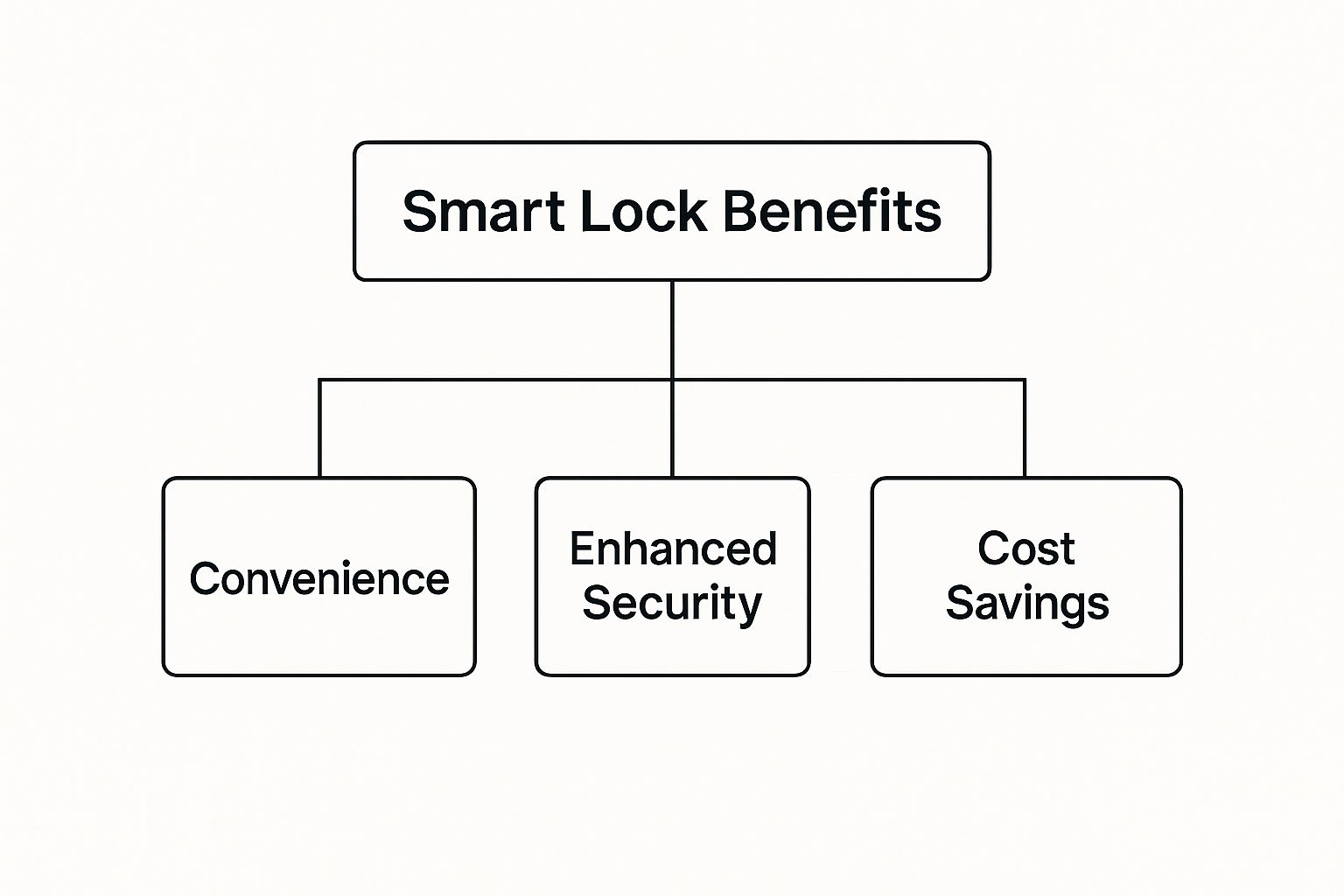
Manage Everything From Anywhere
For property managers, one of the most powerful tools is remote management. From a single dashboard, you can oversee access for your entire portfolio without having to set foot on the property.
This means you can grant access to a new tenant the second their lease starts or revoke it the moment a former resident moves out. Forget scheduling appointments to collect old keys. This saves a ton of administrative hours and, more importantly, closes major security holes instantly.
A huge operational win is eliminating "key float"—that black hole of unaccounted-for physical keys floating around with past tenants, contractors, and former staff. With smart locks, you always know exactly who has access in real-time.
See Everything With Detailed Activity Logs
Finally, every smart lock keeps a detailed digital record. Every single time a door is locked or unlocked, the event is logged with a timestamp. This log tells you exactly which credential was used—be it a mobile key or a specific code—and precisely when it happened.
This gives you incredible visibility and accountability. If a resident claims something went missing after a maintenance call, you can pull up the activity log and see the exact time the maintenance code was used. This data resolves disputes, gives residents peace of mind, and creates a clear, undeniable record of every entry—something a metal key could never do.
How Smart Locks Transform Daily Operations
It's one thing to read a list of smart lock features, but it's another thing entirely to see how they fundamentally change the day-to-day grind of managing a property. This isn't just about convenience; it's about winning back time, cutting real costs, and finally solving some of the most persistent headaches in the business. The most immediate and powerful shift? Saying goodbye to physical keys for good.
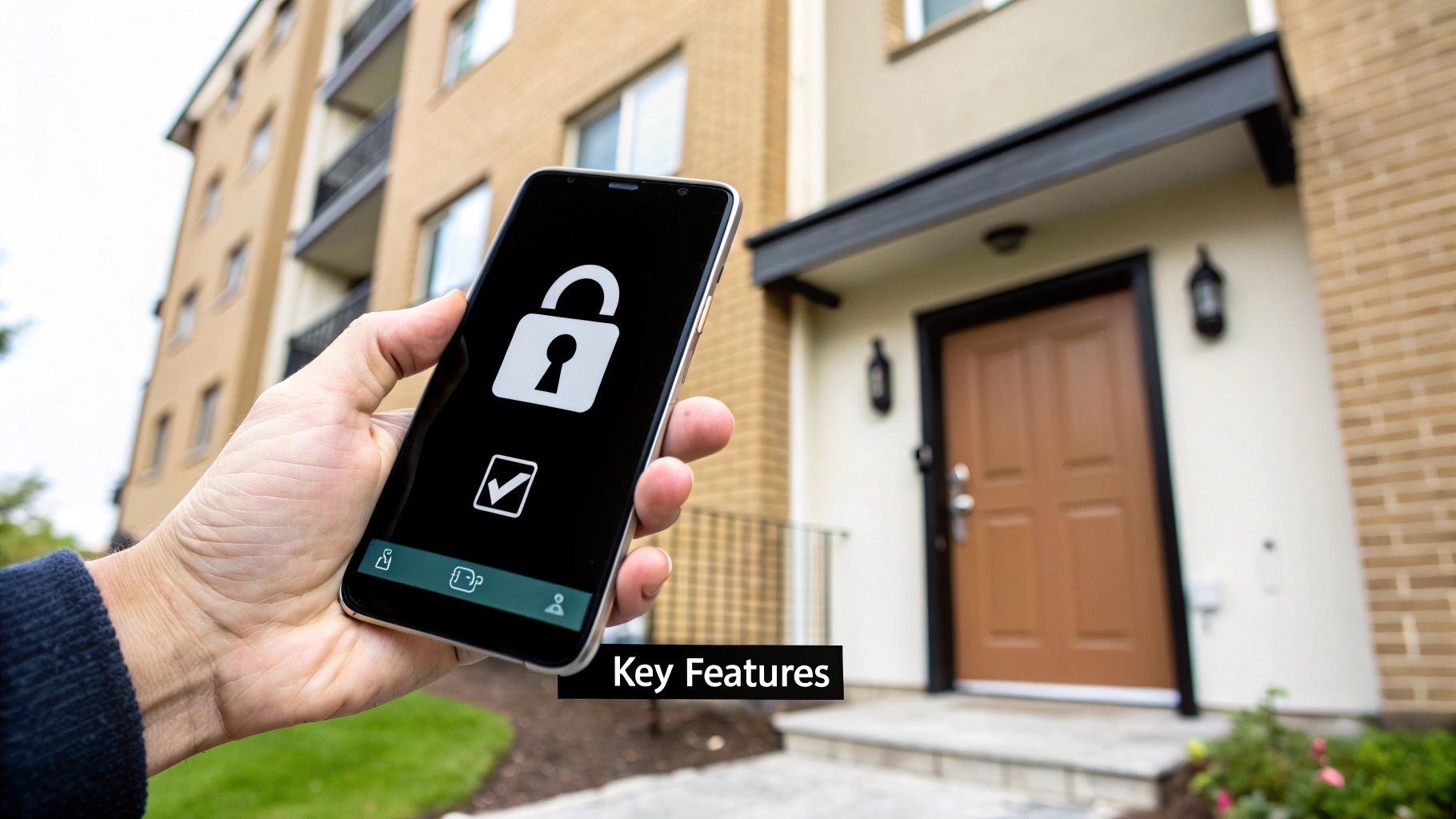
Think about the old routine. A tenant moves out, and your first call is to a locksmith to rekey the unit. That’s a line item on your budget and a block of time you'll never get back. With smart locks for apartments, that whole process just disappears. You revoke access from a central dashboard, and the unit is secure in seconds. The cost? Zero.
This digital control completely changes how you handle master keys, too. Instead of a physical master that could be lost or stolen—creating a security nightmare for the entire property—your staff gets digital credentials with specific, managed permissions. It’s a simple change that closes a huge liability gap, giving both you and your residents genuine peace of mind.
A Day in the Life With Smart Access
To really get a feel for the difference, let's walk through a typical Tuesday for a property manager—first the old way, then the new way.
Before Smart Locks (The Old Way):
- 8:30 AM: A tenant calls, locked out. You have to drop what you’re doing, find the spare key, and walk over to let them in. Your morning schedule is already shot.
- 11:00 AM: The plumber is here for a work order. You have to meet them, unlock the door, and then circle back later to lock up. That's two more interruptions.
- 2:00 PM: A hot lead wants to see a vacant unit, but you're stuck in a meeting across town. You have to reschedule, hoping they don't lose interest and sign somewhere else.
- 4:30 PM: A tenant moves out but "forgets" to return their key. Now you're scrambling to schedule a rekey before the new resident moves in tomorrow.
After Smart Locks (The New Way):
- 8:30 AM: A locked-out tenant calls. From your desk, you remotely unlock their door. The whole thing takes less than a minute.
- 11:00 AM: You issue the plumber a temporary access code that's only good for the next two hours. They let themselves in, do the work, and you get a notification when they leave.
- 2:00 PM: You text the prospect a secure link for a self-guided tour with a one-time code. They see the apartment on their own schedule, and you just enabled a great leasing experience.
- 4:30 PM: The moment the old tenant is out, you revoke their digital key from your computer. The unit is instantly secured and ready for turnover.
The contrast is night and day. The new workflow isn't just faster; it's more secure, more responsive, and built for how people expect to live and work today.
Accelerating Leasing With Self-Guided Tours
One of the biggest operational game-changers that smart locks enable is the self-guided tour. In a competitive rental market, the property that offers the most convenience often wins. Smart locks let prospective renters tour your vacant units whenever it works for them, no agent required.
This is a massive win for everyone involved. Prospects appreciate the flexibility, and your leasing staff is freed up from playing doorman to focus on closing deals. The result is a much shorter leasing cycle, which means less vacancy loss and more money in the bank.
By removing the bottleneck of scheduling in-person tours, properties can show units more often, attract a wider audience, and ultimately, sign leases faster. It takes a time-consuming manual task and turns it into a smooth, automated advantage.
Streamlining Maintenance and Vendor Access
Let's be honest—coordinating access for maintenance staff and outside vendors has always been a pain. It means tracking keys, juggling schedules, and making sure doors get locked again afterward. Smart locks replace that chaos with a clean, trackable system.
You can issue time-sensitive digital keys that grant access only when and where it's needed. For example, a painting crew can be given a code for a specific unit that only works from 9 AM to 5 PM on weekdays. This approach virtually eliminates the risk of unauthorized entry and gives you a complete digital audit trail of who entered and when. That level of control makes managing property maintenance infinitely more efficient and secure.
Choosing the Right Smart Lock System
Picking the right smart lock system isn't just a purchase; it's a major investment that will define the security and day-to-day operations of your entire property. It's easy to get bogged down in technical specs, but the best choice really boils down to a few key factors that are critical for apartment living. If you focus on the right criteria from the get-go, you'll end up with a system that genuinely works for you, not against you.
This decision is more important than ever. The global smart lock market was valued at around USD 3.00 billion in 2024, and it's expected to balloon to USD 15.51 billion by 2035. That explosive growth isn't just a trend; it's a clear signal that both residents and operators prefer the security and sheer convenience that smart locks for apartments deliver.
This isn't just about meeting today's demands. It's about making a smart choice for the future of your property.
Prioritizing Hardware Durability and Battery Life
Think about how many times an apartment door gets used. We're talking thousands of cycles a year. The smart lock you install has to be tough enough to handle that kind of constant use. This is where you need to look for commercial-grade hardware, often certified with ANSI/BHMA ratings that test for durability and security. A standard residential smart lock from a big-box store just isn't going to cut it in a multifamily building.
Battery life is just as critical. The last thing any property manager wants is a flood of maintenance tickets for dead batteries. The best smart lock systems designed for apartments will give you 12-24 months of life from a single set of batteries. More importantly, they should send low-battery alerts straight to your management dashboard, so your team can swap them out long before a resident is ever locked out.
A key question for any vendor should be: "How does your system alert us to low batteries, and what is the typical battery lifespan under heavy use?" This simple question can save you from countless future operational headaches.
Connectivity That Just Works
Smart locks need a way to talk to your management software, and they usually do this with either Wi-Fi or Bluetooth. Understanding the pros and cons of each is vital for matching a system to your building's infrastructure.
- Bluetooth (BLE): This is the king of power efficiency, which is fantastic for battery life. The lock connects directly to a resident's phone when they're close by. To manage it remotely, these locks usually talk to a central hub or gateway that's plugged into an internet connection.
- Wi-Fi: These locks connect right to your building's Wi-Fi network. That means you get real-time access and monitoring from anywhere without needing a separate hub. The trade-off? It can be a bigger drain on the batteries, and you absolutely need a strong, reliable Wi-Fi signal across your entire property.
When you're evaluating systems, it’s also a good idea to brush up on essential access control best practices to ensure you're creating a secure and functional environment.
The Power of a Centralized Management Platform
The real magic of a smart lock system isn't the lock on the door—it's the software that runs the show. A powerful, centralized management platform is absolutely non-negotiable. This is your command center. From a single dashboard, you should be able to grant or revoke access instantly, pull activity logs, and manage your entire portfolio.
The platform you choose has to scale with your business. Whether you’re upgrading a single 50-unit property or managing 5,000 units nationwide, the system should handle that growth without becoming clunky or complicated. A truly scalable platform turns your investment into a long-term asset, not just a short-term fix.
Getting a Real Return on Your Smart Lock Investment
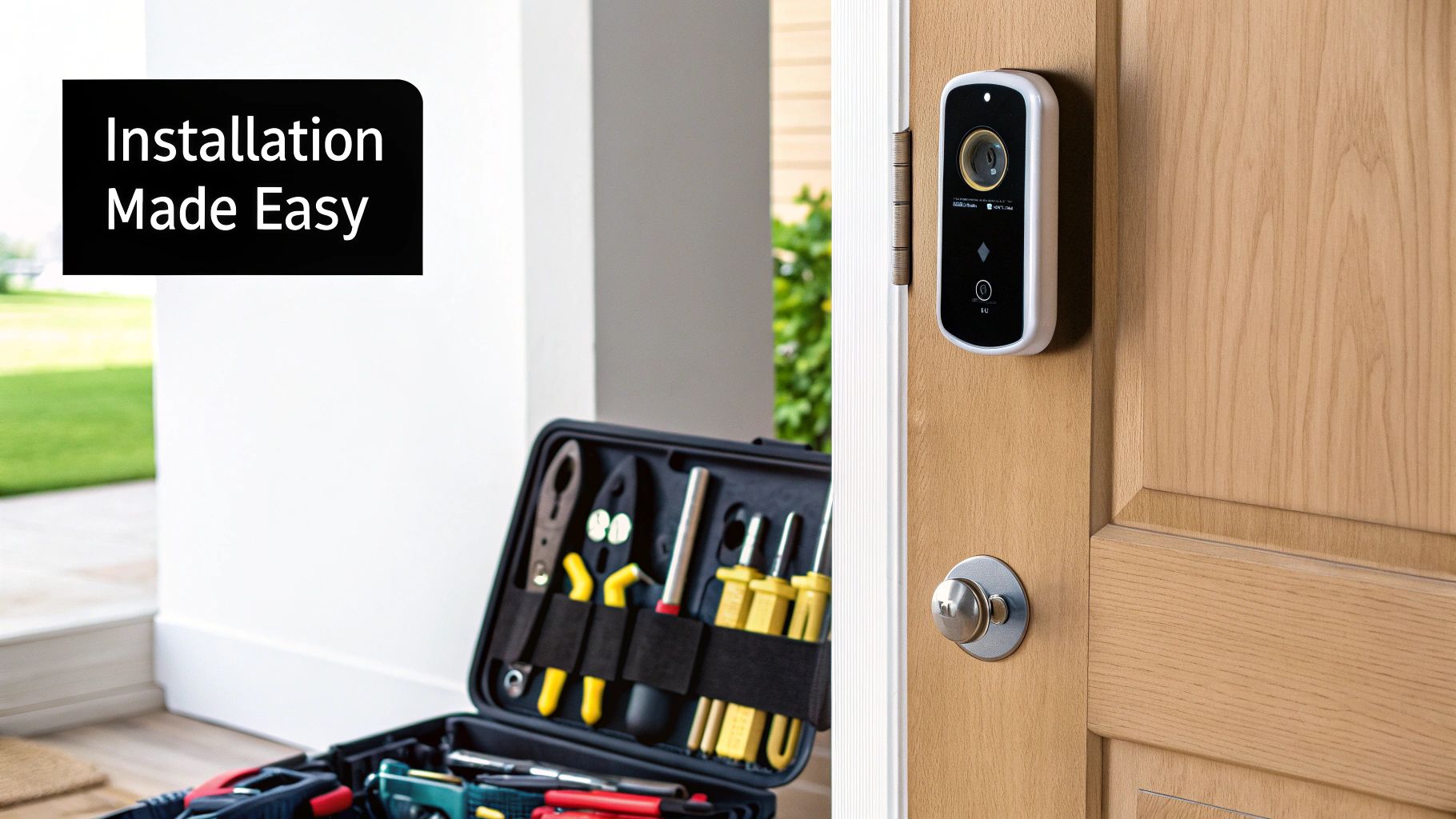
Let's be honest—upgrading to smart locks for apartments is a big move, and you need to know the numbers will work in your favor. Beyond all the cool features and operational perks, this technology has to deliver a real, measurable return on investment (ROI).
The good news is that the financial case for smart locks is built on two solid pillars. First, there are the tangible cost savings you'll see from day one. Second, there are new ways to grow your revenue and boost your net operating income (NOI). It's not just an expense; it’s an investment that pays for itself and then starts putting money back into your pocket.
How You'll Save Money, Right Away
The most immediate financial win comes from ditching old, inefficient processes. Those little costs associated with managing physical keys really start to add up, and smart locks just wipe them off the books entirely.
Here's where you'll see the biggest savings:
- No More Rekeying: The cost to rekey a single lock can easily run between $75 and $150. If you have a 100-unit building with a 50% annual turnover, you're spending $3,750 to $7,500 every single year just on rekeys. Smart locks bring that cost down to zero.
- Fewer Wasted Staff Hours: Think about all the time your team spends juggling keys, letting vendors in, or dealing with late-night lockout calls. Automating access frees them up to focus on what really matters—leasing apartments and keeping residents happy.
- Lower Liability and Insurance Headaches: A lost master key is a nightmare scenario. It’s a huge security risk that can force a property-wide rekey and even make your insurance premiums go up. With digital access logs, you know exactly who entered and when, drastically reducing that risk.
By breaking the endless cycle of rekeying and manual key management, property managers can reclaim thousands of dollars in direct costs and countless staff hours every year. That operational efficiency is the foundation of your ROI.
How You'll Generate New Revenue
Saving money is great, but smart locks also open up brand new income streams. They create a modern living experience that today’s renters actively seek out—and are willing to pay more for. If you want to dive deeper, we break this down in our guide on the ROI for properties upgrading with technology.
The demand is undeniable. The smart lock market has been growing like crazy, with revenues expected to jump from $2.0 billion in 2018 to a whopping $10.8 billion by 2029. This shows just how much people want the convenience and security of keyless living, and that's an opportunity for you.
Here’s how to turn that demand into dollars:
- Add a Smart Home Amenity Fee: It’s now common practice to charge a modest monthly fee of $20 to $40 for a "smart home package." Since 65% of renters say they’d pay more for these features, it's a straightforward way to generate ancillary income.
- Attract and Keep Better Tenants: Tech-forward properties don’t just attract more tenants; they attract higher-quality tenants who appreciate premium features. On top of that, 77% of renters would consider signing a longer lease for smart amenities, which means less turnover for you.
- Justify Higher Rents: Smart features give your property a real edge. When 52% of renters would pick a slightly more expensive smart apartment over a basic one, you have a clear justification for setting more competitive rental rates.
Planning a Smooth Smart Lock Deployment
Rolling out smart locks across an apartment building is about a lot more than just slapping new hardware on doors. It takes a real strategy to get your staff, residents, and the building itself ready for the upgrade. Think of it like installing a new central nervous system for your property; the prep work you do upfront makes all the difference between a smooth transition and a chaotic one.
A solid plan heads off technical glitches before they start, gets residents excited about the new tech, and makes sure you reap the full benefits right from day one. It turns a complex project into a predictable, manageable process.
Assess Your Digital Foundation
First things first: before a single lock gets installed, you have to take a hard look at your property's network infrastructure. Most modern smart lock systems, especially the ones you can manage remotely in real-time, need a rock-solid Wi-Fi connection to work properly. A spotty network will just lead to delayed commands, frustrating lockouts, and a headache for everyone involved.
Your network assessment needs to answer a few critical questions:
- Signal Strength: Is your Wi-Fi signal strong and reliable everywhere it needs to be—in common areas and, most importantly, right at each resident's front door?
- Bandwidth Capacity: Can your current network handle the extra load from hundreds of new smart devices without grinding to a halt?
- Security Protocols: Is your network locked down tight to protect the sensitive access data that will be flying through the air?
A robust, property-wide network isn't a luxury anymore; it’s the bedrock of a modern apartment building. If you need to shore up your building's connectivity, our guide on setting up reliable WiFi for apartment buildings is a great place to start.
Run a Pilot Program First
Don't try to tackle the entire property at once. A much smarter move is to start with a small, controlled pilot program. Pick a handful of units—maybe one floor or a single small building—and test the whole system out in a real-world setting. This trial run is your chance to iron out all the wrinkles before the main event.
A pilot gives you priceless feedback from both your staff and a small group of residents. You’ll quickly find out about any installation hiccups, see how intuitive the software really is, and get a feel for the lock's battery life. This is the crucial feedback loop that will help you perfect your process and build confidence in the new system.
A pilot program is the dress rehearsal for your property-wide deployment. It shines a light on hidden problems and gives you a blueprint for success, saving you from expensive mistakes and unhappy residents later on.
Integrate With Your Property Management Software
The real magic of smart locks for apartments happens when you connect them to your existing Property Management Software (PMS). This integration automates one of the biggest time-sucks in property management: access control.
Imagine this: a new resident signs their lease in your PMS, and the system automatically creates their digital key and sends it to their phone, ready for move-in day. When their lease is up, their access is cut off instantly and automatically. This seamless workflow gets rid of manual key handoffs, slashes the risk of human error, and keeps your property secure during turnover. It turns your smart locks from a cool gadget into a core part of how you run your business.
Got Questions About Apartment Smart Locks? We've Got Answers.
Moving away from traditional keys is a big step, so it’s completely normal to have a few questions. Let's tackle the most common concerns we hear from property managers to help you get a clear picture of how this technology really works in a multifamily setting.
The number one question is always about security. Are these things actually safer than a good old-fashioned deadbolt? In almost every way, yes. Smart locks aren't just physically tough; they use powerful encryption to protect the digital "keys," making them extremely difficult for anyone to hack.
But the real security win is the elimination of the physical key itself. Think about it: no more worrying about lost or copied keys. Plus, every time a door is opened, it creates a digital record, giving you an audit trail that a metal key could never provide.
What Happens When the Power or Wi-Fi Goes Out?
This is a huge—and very valid—concern. The good news is that high-quality smart locks for apartments are designed with exactly this scenario in mind. They don’t rely on constant power or an internet connection to work.
These locks run on their own batteries, which typically last a solid 12-24 months, and they’ll give you plenty of low-battery warnings. If the building’s power or Wi-Fi does go down, residents have several ways to get in:
- Bluetooth Access: Their smartphone talks directly to the lock using Bluetooth, no Wi-Fi needed.
- PIN Codes: Keypad codes are stored right on the lock, so they work offline.
- Physical Key Override: As a final, foolproof backup, there’s always a traditional key.
A well-designed smart lock system is built with multiple layers of redundancy. It ensures that a temporary power or internet outage never compromises a resident's ability to securely access their home.
How Do We Get Residents On Board?
Finally, how do you introduce new tech without causing a headache for your residents? A smooth rollout all comes down to great communication and a little hands-on support. The goal is to make residents feel excited about the upgrade, not anxious.
Give everyone a heads-up well in advance, focusing on the new security and convenience they'll enjoy. Before installation day, send out simple guides and maybe even a quick video showing how everything works. When it's time to go live, having staff on-site to walk people through it makes all the difference and creates a positive experience from day one.
Ready to modernize your property's access control? Clouddle Inc delivers integrated security solutions that boost your operational efficiency and resident satisfaction. Learn more about our managed technology services at clouddle.com.


